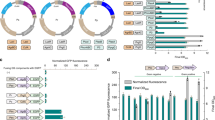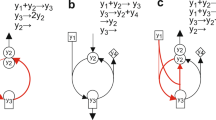Abstract
Synthetic biochemistry seeks to engineer complex metabolic pathways for chemical conversions outside the constraints of the cell. Establishment of effective and flexible cell-free systems requires the development of simple systems to replace the intricate regulatory mechanisms that exist in cells for maintaining high-energy cofactor balance. Here we describe a simple rheostat that regulates ATP levels by controlling the flow down either an ATP-generating or non-ATP-generating pathway according to the free-phosphate concentration. We implemented this concept for the production of isobutanol from glucose. The rheostat maintains adequate ATP concentrations even in the presence of ATPase contamination. The final system including the rheostat produced 24.1 ± 1.8 g/L of isobutanol from glucose in 91% theoretical yield with an initial productivity of 1.3 g/L/h. The molecular rheostat concept can be used in the design of continuously operating, self-sustaining synthetic biochemistry systems.
This is a preview of subscription content, access via your institution
Access options
Access Nature and 54 other Nature Portfolio journals
Get Nature+, our best-value online-access subscription
$29.99 / 30 days
cancel any time
Subscribe to this journal
Receive 12 print issues and online access
$259.00 per year
only $21.58 per issue
Buy this article
- Purchase on Springer Link
- Instant access to full article PDF
Prices may be subject to local taxes which are calculated during checkout




Similar content being viewed by others
References
Cameron, D.E., Bashor, C.J. & Collins, J.J. A brief history of synthetic biology. Nat. Rev. Microbiol. 12, 381–390 (2014).
Kwok, R. Five hard truths for synthetic biology. Nature 463, 288–290 (2010).
Zhang, Y.-H.P. Simpler is better: high-yield and potential low-cost biofuels production through cell-free synthetic pathway biotransformation (SyPaB). ACS Catal. 1, 998–1009 (2011).
Zhang, Y.-H.P. Production of biocommodities and bioelectricity by cell-free synthetic enzymatic pathway biotransformations: challenges and opportunities. Biotechnol. Bioeng. 105, 663–677 (2010).
Schultheisz, H.L., Szymczyna, B.R., Scott, L.G. & Williamson, J.R. Pathway engineered enzymatic de novo purine nucleotide synthesis. ACS Chem. Biol. 3, 499–511 (2008).
Schultheisz, H.L., Szymczyna, B.R., Scott, L.G. & Williamson, J.R. Enzymatic de novo pyrimidine nucleotide synthesis. J. Am. Chem. Soc. 133, 297–304 (2011).
Rollin, J.A., Tam, T.K. & Zhang, Y.-H.P. New biotechnology paradigm: cell-free biosystems for biomanufacturing. Green Chem. 15, 1708–1719 (2013).
Krutsakorn, B. et al. In vitro production of n-butanol from glucose. Metab. Eng. 20, 84–91 (2013).
Hodgman, C.E. & Jewett, M.C. Cell-free synthetic biology: thinking outside the cell. Metab. Eng. 14, 261–269 (2012).
Zhu, Z., Kin Tam, T., Sun, F., You, C. & Percival Zhang, Y.-H. A high-energy-density sugar biobattery based on a synthetic enzymatic pathway. Nat. Commun. 5, 3026 (2014).
Zhang, Y.-H.P., Evans, B.R., Mielenz, J.R., Hopkins, R.C. & Adams, M.W.W. High-yield hydrogen production from starch and water by a synthetic enzymatic pathway. PLoS One 2, e456 (2007).
Ye, X. et al. Spontaneous high-yield production of hydrogen from cellulosic materials and water catalyzed by enzyme cocktails. ChemSusChem 2, 149–152 (2009).
Welch, P. & Scopes, R.K. Studies on cell-free metabolism: ethanol production by a yeast glycolytic system reconstituted from purified enzymes. J. Biotechnol. 2, 257–273 (1985).
Korman, T.P. et al. A synthetic biochemistry system for the in vitro production of isoprene from glycolysis intermediates. Protein Sci. 23, 576–585 (2014).
Guterl, J.-K. et al. Cell-free metabolic engineering: production of chemicals by minimized reaction cascades. ChemSusChem 5, 2165–2172 (2012).
Opgenorth, P.H., Korman, T.P. & Bowie, J.U. A synthetic biochemistry module for production of bio-based chemicals from glucose. Nat. Chem. Biol. 12, 393–395 (2016).
Opgenorth, P.H., Korman, T.P. & Bowie, J.U. A synthetic biochemistry molecular purge valve module that maintains redox balance. Nat. Commun. 5, 4113 (2014).
Atsumi, S. et al. Evolution, genomic analysis, and reconstruction of isobutanol tolerance in Escherichia coli. Mol. Syst. Biol. 6, 449 (2010).
Atsumi, S. et al. Engineering the isobutanol biosynthetic pathway in Escherichia coli by comparison of three aldehyde reductase/alcohol dehydrogenase genes. Appl. Microbiol. Biotechnol. 85, 651–657 (2010).
Li, X., Shen, C.R. & Liao, J.C. Isobutanol production as an alternative metabolic sink to rescue the growth deficiency of the glycogen mutant of Synechococcus elongatus PCC 7942. Photosynth. Res. 120, 301–310 (2014).
Atsumi, S., Hanai, T. & Liao, J.C. Non-fermentative pathways for synthesis of branched-chain higher alcohols as biofuels. Nature 451, 86–89 (2008).
Valverde, F., Losada, M. & Serrano, A. Engineering a central metabolic pathway: glycolysis with no net phosphorylation in an Escherichia coli gap mutant complemented with a plant GapN gene. FEBS Lett. 449, 153–158 (1999).
Van Schaftingen, E. et al. Metabolite proofreading, a neglected aspect of intermediary metabolism. J. Inherit. Metab. Dis. 36, 427–434 (2013).
Didierjean, C. et al. Crystal structure of two ternary complexes of phosphorylating glyceraldehyde-3-phosphate dehydrogenase from Bacillus stearothermophilus with NAD and D-glyceraldehyde 3-phosphate. J. Biol. Chem. 278, 12968–12976 (2003).
Acknowledgements
The authors thank members of the Bowie lab for helpful comments. This work was supported by DOE grants DE-FC02-02ER63421 and DE-AR0000556 to J.U.B.
Author information
Authors and Affiliations
Contributions
P.H.O., T.P.K. and J.U.B. contributed to the system design. P.H.O., T.P.K., L.I. and J.U.B. contributed to the design of experiments and data analysis. P.O., L.I. and T.K. performed the experiments. P.H.O., T.P.K. and J.U.B. wrote the paper.
Corresponding author
Ethics declarations
Competing interests
The authors have formed a company, Invizyne Technologies, that will seek to exploit cell-free technologies.
Supplementary information
Supplementary Text and Figures
Supplementary Results, Supplementary Tables 1–7, Supplementary Figures 1–4 and Supplementary Note (PDF 1061 kb)
Rights and permissions
About this article
Cite this article
Opgenorth, P., Korman, T., Iancu, L. et al. A molecular rheostat maintains ATP levels to drive a synthetic biochemistry system. Nat Chem Biol 13, 938–942 (2017). https://doi.org/10.1038/nchembio.2418
Received:
Accepted:
Published:
Issue Date:
DOI: https://doi.org/10.1038/nchembio.2418
This article is cited by
-
Synthetic anaplerotic modules for the direct synthesis of complex molecules from CO2
Nature Chemical Biology (2023)
-
A balancing act
Nature Chemical Biology (2023)
-
Toward bioproduction of oxo chemicals from C1 feedstocks using isobutyraldehyde as an example
Biotechnology for Biofuels and Bioproducts (2022)
-
A roadmap towards integrated catalytic systems of the future
Nature Catalysis (2020)
-
Isobutanol production freed from biological limits using synthetic biochemistry
Nature Communications (2020)



